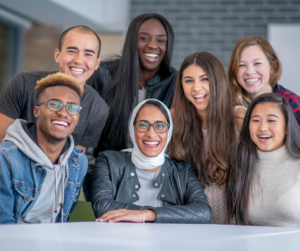
By Julie Kucks

Holistic education is a learning philosophy that believes students are people, not simply academics, and should thus be educated as a whole person. This means that developing a student’s social, emotional, and ethical wellbeing is the responsibility of a teacher, along with ensuring academic success. Holistic education has gained popularity in recent years as a response to the increased learning loss and school dropouts that have occurred post-COVID. Trends in both higher education and the workforce also reveal that a holistic education better prepares students for academic and work-life success.
The 3rd Edition of the Connected Student Report surveyed 2,668 students from 11 countries, revealing the top needs students have at a university level to help them succeed. Not surprisingly, all four are related to an institutional lack of holistic education.
Our CHP faculty believe a holistic approach is the best way forward in education and believes these surveyed students have given us critical guideposts for reimagining how we educate at a lower-school level.
Here are the four biggest holistic education approaches students say they need to succeed.
A sense of belonging

Students said their ability to succeed at an educational institution is determined by their experience on campus within the first few weeks. First impressions and an immediate sense of belonging are foundational for a student’s motivation to work.
Belonging is generally defined as a feeling of happiness and comfort with members of a group. Research shows that a sense of belonging is a critical psychological piece to a student’s ability to learn. When students feel like they are outside of a group, their mind is distracted with fighting stereotypes, identifying discrimination, and building up defense mechanisms rather than absorbing and processing information.
We live in a lonely time. One in five Americans experiences chronic loneliness with those highest at-risk being teenagers and young adults. In our socially and politically fragmented society, young people’s sense of belonging is being threatened – a belonging that underpins their ability to learn.
Qualtric’s shared research clearly shows us how important a sense of belonging is to ensure students remain in school. Because a holistic education involves caring for a student’s emotional and social wellbeing, it is a highly effective approach for creating a sense of belonging within the education system.
At CHP, we work to create a school environment where every student is accepted and supported for exactly who they are. With students from over 26 countries, celebrations of our community’s cultures are an organic part of our school element. We teach our students that we become stronger when we learn from each other’s experiences and strive to understand one another. CHP is always seeking ways to ensure our students feel they belong – and we believe it is the responsibility of all education systems to do the same.
How to create a sense of belonging for students
 Be a person. Having teachers create a personal connection with students and treat them like the people they are will automatically foster an intimate, caring connection rather than a hierarchical one. It’s important for educators to be honest and be humble. We must share what we know, help our young people understand the content deeply, and invest ourselves in understanding where they’re coming them.
Be a person. Having teachers create a personal connection with students and treat them like the people they are will automatically foster an intimate, caring connection rather than a hierarchical one. It’s important for educators to be honest and be humble. We must share what we know, help our young people understand the content deeply, and invest ourselves in understanding where they’re coming them.- Encourage discourse. Research shows the age-old lecturing model is becoming more and more ineffective. It is important for us to transition our educational models from a teacher-centered approach to a student-centered one. At CHP, we believe young people’s in-bred curiosity is the best guide and motivator for their educational pursuits. Within our curriculum, we ensure that our classroom model is ACTIVE. There is time in the day where young people are free to explore, ask questions, experiment, and effectively communicate their feelings about what they are learning.
- Expect respect and empathy. It is every educator’s mission to make it clear from the get-go that the classroom is a place for students to respect and support each other. Teaching young people to practice empathy and curate interest in people’s diverse experiences helps foster everyone’s sense of belonging.
Institutional support academically and emotionally
Among the students surveyed for the Connected Student Report, 40% reported that they need more help managing their schoolwork and 36% reported needing more well-being support to reach their goals. 76% of people who had a positive school experience said this was due to feeling adequately supported by their institution.
This support is lacking in today’s educational system. American schools create conveyor belt curricula that is chosen without input from student, parent, or teacher. Independent learning is discouraged while rote memorization and regurgitation is encouraged. This creates a very narrow tunnel of success leaving those students who have differing learning styles and capabilities overwhelmed.
This one-dimensional approach also creates a conflict of interest for teachers. Rather than expending energy on mentoring and supporting students, they are expected to adhere to a “no student left behind policy,” prioritizing passing grades over their students’ comprehension or mental wellness.
CHP was created with a vision to offer students academic rigor along with personal development. Our educators understand that to be a powerful teacher, one must be a powerful mentor. Our faculty are here to help your student grow academically but also to grow in their self-confidence, self-belief, and self-motivation so their future success is built on a solid foundation.
How to create support systems for students
 Create smaller class sizes. Minimizing the number of students to a classroom allows room for individuals to grow. Teachers have the emotional space to interact with individual questions and concerns and students have room to share and express themselves. This is a powerful piece to CHP’s thriving sense of community.
Create smaller class sizes. Minimizing the number of students to a classroom allows room for individuals to grow. Teachers have the emotional space to interact with individual questions and concerns and students have room to share and express themselves. This is a powerful piece to CHP’s thriving sense of community.- Practice looping. We find this recommendation from Next Generation Learning Challenges’ blog really innovative. Looping is the idea that a teacher stays with a generation of students over a period of time. Rather than a teacher moving to a new class each year and rebuilding relationships, looping allows the time to build a teacher-student unit that naturally instills trust and support.
- Promote mental health awareness. It’s estimated that one in five people live with a mental illness. Training school advisors and faculty in mental health awareness and openly spreading information about mental health in the school setting helps destigmatize it and lets those students who are struggling know they are seen and supported. Our faculty at CHP work to recognize when a child is struggling with their mental health and know how to properly respond
Preparation for future work

47% of students surveyed in the Connected Student Report said they chose their major based on career opportunities it would offer but only 11% reported feeling prepared for their chosen career. Nearly half of these students said they would pursue another higher education path before starting to work. And a Cengage survey recently discovered that more than half of graduates have not applied to entry-level jobs because they don’t feel confident in their abilities.
The reality is that the U.S. education system is not giving students what employers need. Since the pandemic, job-listings requiring a bachelor’s degree have dropped by 45%, indicating employers are prioritizing employees with skills versus a college degree. It also indicates a certain lack of confidence that a college degree guarantees skill.
How do we prepare students better for the future? It is critical that we stop worshipping academic hyper-specialization and start valuing a diverse, experiential background.
The Atlantic recently published a piece encouraging readers to diversify their work and life experiences in order to think like a CEO. CEOs who have had diverse personal and work backgrounds are reporting that they are better able to handle the myriad pressures, problem-solving, and innovation the position requires because they’ve learned how to think rather than simply parrot skills.
How to prepare students for the future
- Teach them how to think. Education must become more concerned with instructing students how to activate, energize, and apply their minds rather than learning facts. Meditation, problem-solving, experimentation, and play are powerful ways to encourage the mind’s growth. With our beautiful 9-acre campus, CHP is able to offer students a unique connection with nature which allows them to experiment, observe, and listen in the great outdoors.
- Teach them how to feel. Education should not be emotionless. It’s important to get students emotionally engaged in what they’re learning. By connecting students personally with specific issues that inspire or charge them, their motivation to learn increases and they will be more engaged. Making education personal also shows students that their life experiences are important and encourages them to use their personal backgrounds in their learning process.
- Teach them how to act. So much of the education in America is passive. We need to create spaces for our students to go out and act! CHP actively improves students’ academic ability when we have biology lessons outdoors, help them create composting systems, give them garden plots to maintain, and take them on local field trips – all of these activities get students out of the chair and into the “real world.”
Diversity & Flexibility

With the world going online post-pandemic and virtual learning becoming the norm, students have become accustomed to flexible learning options. They want to be able to work their education schedule around their life, not the other way around. Students are making clear that they expect ease, flexibility, and availability when it comes to online educational resources.
Diversity is another big expectation students have for academic and personal success. Gen Z is passionate about having diversity in every quarter of life – in race, culture, gender, and self-identity. Studies have shown that diverse classrooms improve the richness of education by allowing students to explore differences, be confronted with and actively work against prejudice, and learn the importance of cross-cultural appreciation.
How to encourage flexibility & diversity
- Incorporate apps. The world today is a virtual playground for education apps. There are apps specifically designed for use in schools that are a good way to include valuable, flexible learning options for students. There are also many education apps parents can utilize with their kids outside of school hours to keep them curious and learning throughout the entire day.
- Have students take digital citizenship classes. Being a good digital citizen involves following appropriate and kind etiquette online. Having students take a digital citizenship class will help them navigate cybersecurity and learn respectful behavior toward others online.
- Present diverse perspectives. As educators, we have the power to choose the perspective and background of the information our students receive. At CHP, we work to give them diverse perspectives in the classroom by introducing authors with different backgrounds, sharing the stories of a variety of historical figures, and explaining multiple philosophical or religious points of view. This shows our students that everyone’s experience is important and that the world is made up of countless perspectives which is a beautiful thing.
We have a long way to go to revolutionize our education practices. It’s important for us to encourage one another to be innovative and to not be afraid of the hard work. It’s important for parents and educators to be in communication about how best to serve our young people. And it is always important that we ask and listen to the very amazing people we are working to educate – our beloved students.





